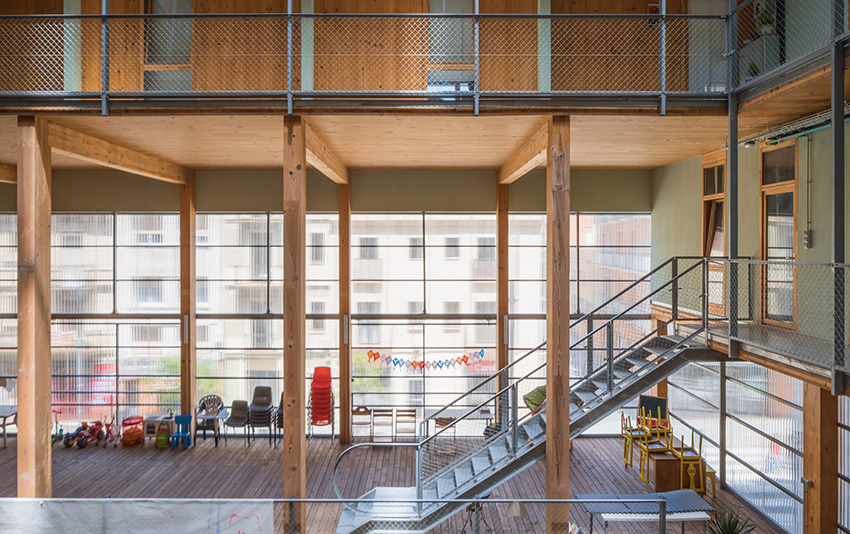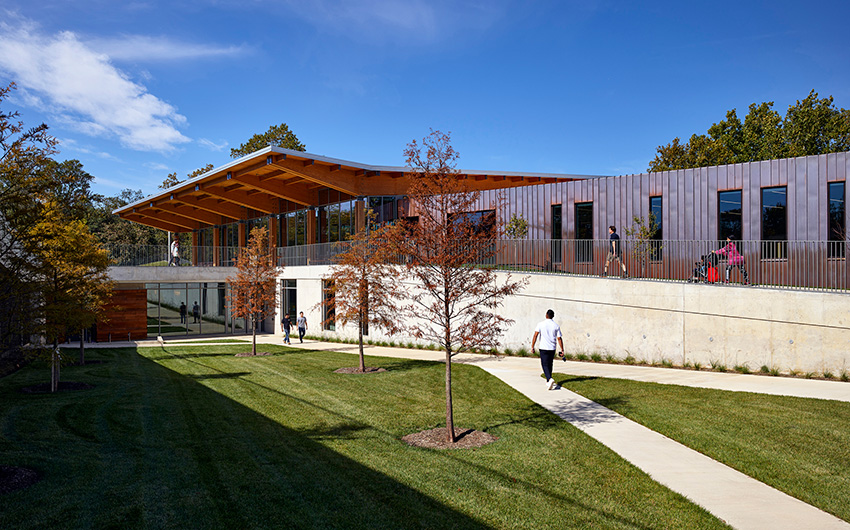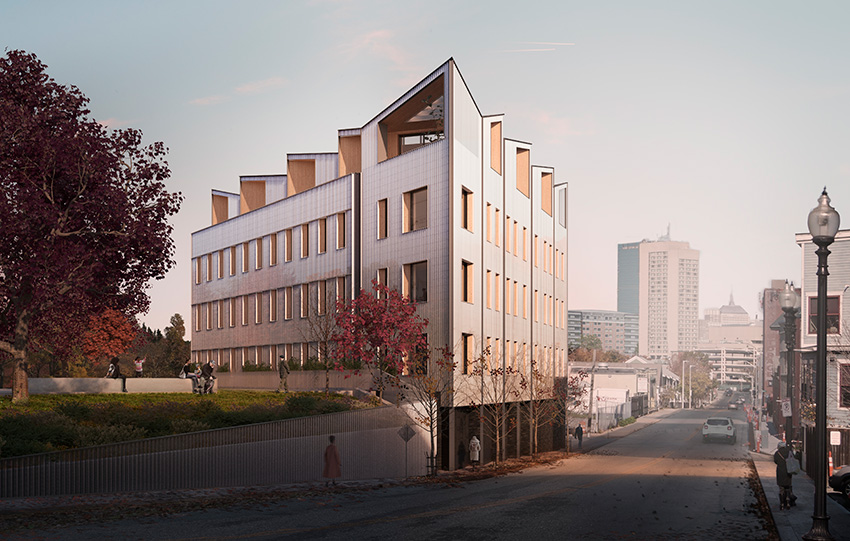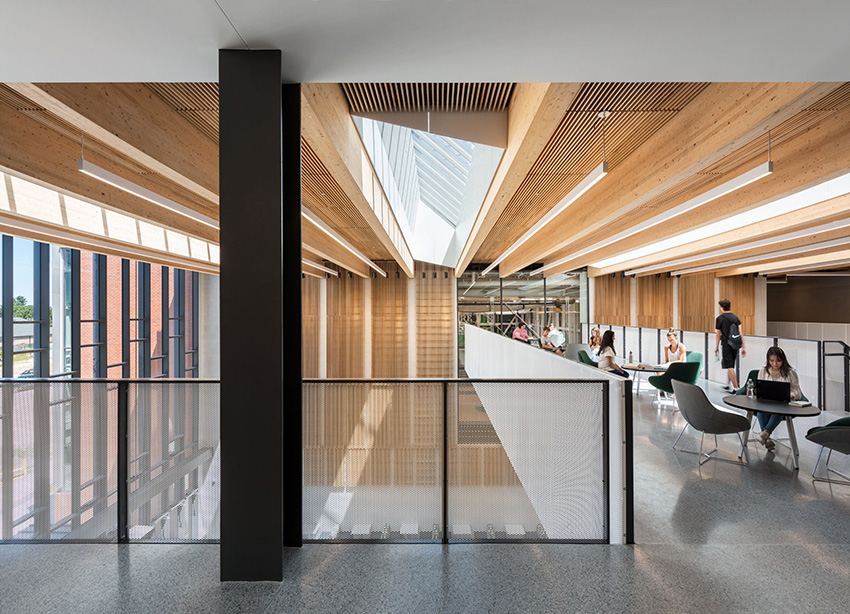THE DECADE AHEAD: DESIGN AND CITIES IN 2021 AND BEYOND
Designers Respond to the Demands of a Rapidly Changing World
Over the past decade, the architectural, construction, and engineering (AEC) sector has grappled with unprecedented technological and socioeconomic changes along with an unprecedented confluence of challenges to the health of our communities, our cities, and our planet. Climate change is accelerating—the 10 years leading up to 2020 was the warmest decade on record. Buildings and their construction account for 39% of global carbon dioxide emissions. At the same time, the built environment is growing at a record pace in the United States. It is estimated that 2.5 million new housing units are needed to make up for the nation’s housing shortage, a trend that has not abated in the face of a global pandemic. Economically, the price of housing has eclipsed the income of many Americans—precipitating a critical housing crisis in some regions—and adding to inequality and a rising homeless population across the nation. Amidst this, we spend as much as 90% of our time indoors, often cut off from nature.
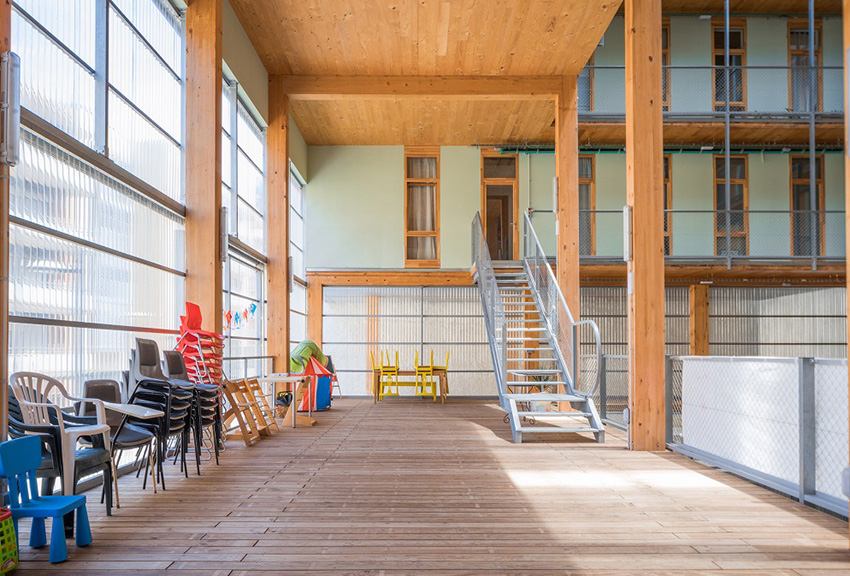
Photo courtesy of Lluc Miralles, courtesy Lacol Arquitectura Cooperativa
La Borda Cooperative Housing in Barcelona. The project's development involved a lengthy community engagement process in which each resident served as a working group member, contributing to the project's design, function, and management.
While these challenges are daunting, thought leaders in the AEC industry increasingly see it as an opportunity to be at the forefront of change, with examples of design leadership across the country and around the world. Technological gains within the built environment are making zero-carbon construction attainable, dramatic energy savings achievable, and taller mass timber construction possible. Industry research, along with bold demonstration projects, is expanding the sector’s understanding of carbon sequestration, life-cycle assessment (LCA), Passive House principles, and biophilic and health-centered design.
Four design approaches are leading the industry’s response to these challenges and opportunities:
- Greenspace Boosting health, resilience, and well-being by including greenspaces in project designs
- A Focus on Community Building + Placemaking Lessons and learnings of community-centered, participatory design
- Lowering Building Carbon Footprints Redesigning the built environment to mitigate climate change
- Designing for Density and Affordability Boosting urban density and affordability through creative means
In this course, you’ll learn from design teams who are embracing these strategies and delivering solutions that begin to address some of the most pressing global challenges of our times.
GREENSPACE: A NATURAL PRESCRIPTION FOR HEALTHIER CITIES
Take a Walk in the Woods and Call Me in the Morning
A healthy city is a green city; a healthy urban dweller, a park-goer. There is ever-growing evidence that local access to greenspace and green views positively impacts physical health, mental well-being, and the overall resilience of a city—defined as its capacity to survive, adapt, and grow in the face of adversity. Easy access to greenspace, urban parks, and nature has been linked with improved human health—everything from better immune function, mental health, and cognitive capacity to a reduction in type 2 diabetes and cardiovascular morbidity. Proximity to greenspace has been correlated with lower rates of psychiatric disorders. Beyond this, a city of well-connected, attractive greenspaces may be better equipped to bounce back from crises, natural disasters, and extreme weather events. These benefits extend to all population groups, particularly marginalized and low-income segments. The science is still emerging and more research is needed, but initial findings and anecdotal reports show promising results. A walk in the woods may be just what the doctor ordered.
Density Isn’t the Problem, Equitable Access to Greenspace Is
Increasing equitable access to greenspace may be the biggest hurdle to countering such crowding and creating more resilient cities. In the U.S. alone, 100 million people (28 million children included) do not have a neighborhood park within a 10-minute walk from home. The good news is, progress is being made. It’s part of a concerted effort called the 10-minute Walk, a nationwide movement championed by The Trust for Public Land, National Recreation and Park Association, and the Urban Land Institute. The program is enlisting mayors from across the nation to improve access to parks and greenspaces.
It Takes a Green Village: Weaving Greenspace and Nature into the Built Environment
Along with increasing equitable access to public parks and recreational amenities, urban designers and architects in cities across the country are increasingly looking for innovative ways to weave greenspace into the built environment.
Garden City 2.0: Building Long-Term Resilience and Health
In times of hardship and crisis, city dwellers throughout history have turned to nature for hope and healing. Today, equipped with a growing body of research and compelling data, city builders are beginning to confirm what folk wisdom has taught us—that nature and greenspace woven into the fabric of our urban environments are good for our health. As Will Allen, director of strategic conservation planning at The Conservation Fund in Chapel Hill, NC writes, “...if a post-COVID world can move towards more people-centered social infrastructure investment, with ambitious goals for nature in cities and biophilic design, then our financial investments in nature will be rewarded with less crowded and more resilient cities, which will hopefully also lead to a more equitable and healthy country.” This investment may very well begin with a walk in the park, just ten minutes from home. The concept of a garden city is one practical response to building stronger, more resilient cities.
THE ARCHITECTURE OF COMMUNITY: PARTICIPATORY DESIGN AND PLACEMAKING BUILD CONNECTION
Along with well-designed equitably planned greenspace, participatory design has the potential to strengthen the health and resilience of communities. A growing number of architects and planners are turning to community engagement—an approach that puts occupants at the heart of the design process. In doing so, they’re creating architecture that connects people and strengthens community, something that is perhaps more important than ever.
Participatory design offers a number of benefits, as pointed out by Participate in Design (P!D). It mitigates the risk of failure and helps a community buy into and own a design solution. It can help reduce resistance to change and encourage realistic expectations of a design while fostering stronger bonds and greater community involvement. And finally, it can boost the overall confidence and resilience of a community.
DESIGNING FOR DENSITY: A BUILT ENVIRONMENT TO ACCOMMODATE GROWING POPULATIONS
The Rising Need for Affordable Housing and Mixed-Use Development
For community building and placemaking to thrive, cities need safe, accessible, and affordable housing, inclusive of a broad socioeconomic spectrum of people. This is becoming even more imperative as urban population growth surges. By 2050, two-thirds of the world’s population will live in urban areas. Outside traditional city centers, urban adjacent suburbs and mid-sized cities and towns also are seeing rapid growth, fueled in part by a shift to remote working in response to the COVID-19 pandemic. As a result, the demand for affordable housing is outpacing supply, with new multifamily units renting at prices that are cost-prohibitive for middle- and low-income renters.
Without cost-effective housing options—and a diverse mix of units from rental and cooperatives to social and market housing—urban centers risk becoming destinations for “global elites.” In some cases, high-priced investment properties sit empty, as a rapidly rising population can’t find housing. Nearly two-thirds of renters nationwide say they can’t afford to buy a home, and saving for a down payment is out of reach when home prices are rising at twice the rate of wage growth. These challenges, compounded by a global pandemic, have only intensified America’s housing problems.
At the same time, infrastructure, amenities, and mixed-use commercial space are needed to support population growth. But land available for such development is costly and scarce, highlighting the need to optimize the use of existing space in urban centers. And now, these same cities must consider how to adapt mixed-use development for a post-pandemic world. Given all these challenges, how can developers, architects, and contractors boost affordability and reduce multifamily housing costs? How can they make better use of available land and optimize the use of existing mixed-use commercial spaces?
What Impact Can Design Teams Have on Density and Affordability?
To answer these questions, designer and urbanist Hannah Hoyt, Gramlich Fellow at Harvard Joint Center for Housing Studies, interviewed 30 professionals working in the development sector. The findings? To help make housing more affordable, the report recommends design teams consider multiple strategies that can curb development costs in three categories: land costs, hard costs, and soft costs, with a focus on what savings are within their day-to-day control and can be passed on to occupants.
Land costs refer to the cost of acquiring land, which amounts to approximately 10-20% of total development costs for a typical multifamily project. Examples of strategies to maximize land value include selecting a site that offers economies of scale, considering design solutions for oddly shaped lots or scattered sites, and renovating, converting, or co-locating housing with existing buildings. A standard approach to site evaluations that considers everything from soil and site clearance to grade and zoning can, according to the report, go a long way to identifying scalability and avoiding unexpected site preparation costs.
Hard costs are the costs of construction, which can be divided into four sub-categories: substructure and site prep, shell and structure, and interiors and services. Hard costs amount to 50-70% of total costs. Examples of strategies that can have a positive impact on hard costs include designing units for maximum flexibility and efficiency, investigating new techniques and materials, and investing in energy and water performance to realize long-term savings for a project.
Finally, soft costs include all other costs—financing, design, engineering, permitting, and any impact fees. In this category, engaging general contractors early and as partners can help realize savings, and sharing more information with subcontractors can result in more accurate cost-estimating.
FROM CARBON SOURCE TO CARBON SINK: REDESIGNING THE BUILT ENVIRONMENT FOR CLIMATE CHANGE
Amidst the urgent need for affordable housing and urban infrastructure, the culminating impacts of a changing climate demand dramatic shifts in how we design and construct our buildings. One important part of the solution—convert the built environment from a significant carbon source to a carbon sink.
The Urgent Need to Lower Building Carbon Footprints
Climate change demands dramatic shifts in how we design and construct our buildings. At the same time, the urgent need for housing and supportive infrastructure continues to surge at record rates. Buildings and their construction account for 39% of global carbon dioxide emissions; 28% of those emissions come from operational carbon—the energy used to power, heat, and cool a building. Buildings’ operational carbon can be reduced through energy efficiency measures, and policymakers, architects, developers, and engineers have made significant advances in this arena. The remaining 11% of carbon emissions are generated from building materials and construction. This “embodied carbon” can account for half of the total carbon footprint over the lifetime of the building.
To reduce the greenhouse gas emissions associated with construction, specifiers and stakeholders need to act now to create embodied carbon strategies that reduce environmental impacts from buildings we’ll use well into the future. The costs of delaying any longer are too high. Greenhouse gas emissions have increased by 90% since 1970. A 1.5% increase in global warming will have catastrophic results for ecosystems and people around the world, including the United States.
Embodied carbon is a priority for many environmental, architecture, and urban planning organizations including C40 Cities, Architecture 2030, Urban Land Institute, and the World Green Building Council. Many experts believe addressing embodied carbon for buildings and building materials is critical to achieving the goals of the Intergovernmental Panel on Climate Change (IPCC) and the 2016 Paris Climate Agreement.
Embodied Carbon in a Building’s Life Cycle
Embodied carbon is determined by conducting a life cycle assessment (LCA) of a product, assembly, or building over declared life-cycle stages. An LCA study returns results for a number of environmental metrics, including the potential to impact climate or “global warming potential” (GWP). Embodied carbon is the GWP result. Embodied carbon is measured for each stage of the product’s life cycle, allowing comparisons across any combination of stages.
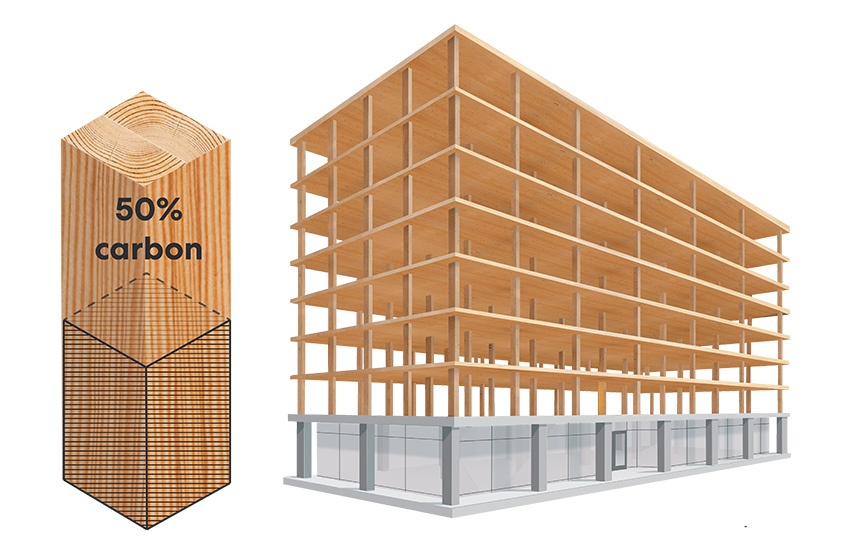
Photo courtesy of Think Wood
Wood products are approximately 50% carbon by dry weight.
As buildings become more energy efficient, the upfront embodied carbon from materials begins to account for a higher proportion of a building’s carbon footprint. Very soon, embodied carbon is likely to become the dominant source of building emissions.
Embodied carbon varies dramatically between concrete, steel, and wood, making product decisions key in achieving lower carbon buildings. Manufacturing wood products requires less total energy, and in particular less fossil energy, than manufacturing most alternative materials including metals, concrete, or bricks.
Embedded Carbon in Wood Products
Embedded carbon is the storage of carbon for long periods of time. Wood products are approximately 50% carbon by dry weight. And wood’s lightweight advantage when it comes to density and city building is making it an attractive climate-smart choice as pointed out in a research paper: Lightweighting with Timber: An Opportunity for More Sustainable Urban Densification. The use of wood products in buildings provides an additional environmental benefit by storing carbon removed from the atmosphere. This ability to sequester, or “embed”, carbon makes wood an ideal product for buildings, which are designed for long service lives. Essentially, a wood building is a large carbon sink. This storage of carbon is a unique environmental attribute that does not exist in other structural products.
Timber as a tactic for curbing climate change is backed by a growing body of research and advancements in calculating the carbon footprint of building materials. In a recent paper published in the journal Nature Sustainability, experts at the Potsdam Institute for Climate Impact Research in Germany delved into four possible scenarios of timber use in buildings over the next 30 years. In the first case, “business as usual,” 0.5% of buildings are made with wood while the vast majority remain constructed of concrete and steel. There’s a 10% timber building scenario; a 50% timber building scenario; and a fourth in which the vast majority—90% of new construction—is made with wood. Their findings suggest that the lowest scenario could result in 10 million tons of carbon stored per year, and in the highest, nearly 700 million tons. “Buildings, which are designed to stay for decades,” researchers write in the paper, “are an overlooked opportunity for a long-term storage of carbon, because most widely used construction materials such as steel and concrete hardly store any carbon.”
While the research is limited to European wood construction, the authors of the study see global potential. “This is the first time that the carbon storage potential of wooden building construction has been evaluated on the European level, in different scenarios,” said Ali Amiri, one of the researchers of the study. “We hope that our model could be used as a roadmap to increase wooden construction.”
ARCHITECTING CHANGE: REASONS FOR OPTIMISM
As design professionals look to the decade ahead, there are many challenges on the horizon, from addressing pressing environmental and social issues to accommodating rapid population growth and shifting market demands. There is a growing understanding that the built environment is inextricably linked to many of the complex issues of our day. While these problems are global in scale and, in some cases, beyond the influence of the AEC industry alone, there are actions design professionals are taking in their day-to-day practice that can begin to make an impact.
A rapidly evolving, post-pandemic world demands adaptive and versatile design professionals who are continually evolving their practice and looking to the latest research and methodologies to help inform their design solutions. Design teams are showing how we can boost health, affordability, and wellness in today’s increasingly dense urban environments through creative, nimble, and flexible thinking.
There is also an urgent need to combat climate change and find advanced ways to store carbon in our buildings. Industry leaders are stepping up with substantial commitments—from conducting leading research on carbon and climate to erecting important demonstration projects. Structural timber is proving to be one significant way to sequester embodied carbon and reduce the environmental footprint of new construction. Ingenuity and smart design also can mitigate the impacts of global warming. Interweaving greenspace into the urban environment and even in and on top of buildings can have a cooling effect on our cities.
Industry leaders are committing to building for a resilient, healthy, and low-carbon future—an ‘architecture of optimism.’ Jordan Goldstein, a design principal at Gensler writes, “Whether it’s new buildings that are about to be designed or existing architecture that now needs to be reimagined, in many ways this is a time for an architecture of optimism. Optimistic architecture isn’t architecture for the sake of architecture and doesn’t seek to glorify form. Rather, it’s an architecture that seeks to express its purpose in every aspect of the design–one that promotes wellness and celebrates life. The time to define this architecture of optimism is now. The future of our cities depends on it.”
SOURCES
THE DECADE AHEAD: DESIGN AND CITIES IN 2021 AND BEYOND
Designers Respond to the Demands of a Rapidly Changing World
Over the past decade, the architectural, construction, and engineering (AEC) sector has grappled with unprecedented technological and socioeconomic changes along with an unprecedented confluence of challenges to the health of our communities, our cities, and our planet. Climate change is accelerating—the 10 years leading up to 2020 was the warmest decade on record. Buildings and their construction account for 39% of global carbon dioxide emissions. At the same time, the built environment is growing at a record pace in the United States. It is estimated that 2.5 million new housing units are needed to make up for the nation’s housing shortage, a trend that has not abated in the face of a global pandemic. Economically, the price of housing has eclipsed the income of many Americans—precipitating a critical housing crisis in some regions—and adding to inequality and a rising homeless population across the nation. Amidst this, we spend as much as 90% of our time indoors, often cut off from nature.

Photo courtesy of Lluc Miralles, courtesy Lacol Arquitectura Cooperativa
La Borda Cooperative Housing in Barcelona. The project's development involved a lengthy community engagement process in which each resident served as a working group member, contributing to the project's design, function, and management.
While these challenges are daunting, thought leaders in the AEC industry increasingly see it as an opportunity to be at the forefront of change, with examples of design leadership across the country and around the world. Technological gains within the built environment are making zero-carbon construction attainable, dramatic energy savings achievable, and taller mass timber construction possible. Industry research, along with bold demonstration projects, is expanding the sector’s understanding of carbon sequestration, life-cycle assessment (LCA), Passive House principles, and biophilic and health-centered design.
Four design approaches are leading the industry’s response to these challenges and opportunities:
- Greenspace Boosting health, resilience, and well-being by including greenspaces in project designs
- A Focus on Community Building + Placemaking Lessons and learnings of community-centered, participatory design
- Lowering Building Carbon Footprints Redesigning the built environment to mitigate climate change
- Designing for Density and Affordability Boosting urban density and affordability through creative means
In this course, you’ll learn from design teams who are embracing these strategies and delivering solutions that begin to address some of the most pressing global challenges of our times.
GREENSPACE: A NATURAL PRESCRIPTION FOR HEALTHIER CITIES
Take a Walk in the Woods and Call Me in the Morning
A healthy city is a green city; a healthy urban dweller, a park-goer. There is ever-growing evidence that local access to greenspace and green views positively impacts physical health, mental well-being, and the overall resilience of a city—defined as its capacity to survive, adapt, and grow in the face of adversity. Easy access to greenspace, urban parks, and nature has been linked with improved human health—everything from better immune function, mental health, and cognitive capacity to a reduction in type 2 diabetes and cardiovascular morbidity. Proximity to greenspace has been correlated with lower rates of psychiatric disorders. Beyond this, a city of well-connected, attractive greenspaces may be better equipped to bounce back from crises, natural disasters, and extreme weather events. These benefits extend to all population groups, particularly marginalized and low-income segments. The science is still emerging and more research is needed, but initial findings and anecdotal reports show promising results. A walk in the woods may be just what the doctor ordered.
Density Isn’t the Problem, Equitable Access to Greenspace Is
Increasing equitable access to greenspace may be the biggest hurdle to countering such crowding and creating more resilient cities. In the U.S. alone, 100 million people (28 million children included) do not have a neighborhood park within a 10-minute walk from home. The good news is, progress is being made. It’s part of a concerted effort called the 10-minute Walk, a nationwide movement championed by The Trust for Public Land, National Recreation and Park Association, and the Urban Land Institute. The program is enlisting mayors from across the nation to improve access to parks and greenspaces.
It Takes a Green Village: Weaving Greenspace and Nature into the Built Environment
Along with increasing equitable access to public parks and recreational amenities, urban designers and architects in cities across the country are increasingly looking for innovative ways to weave greenspace into the built environment.
Garden City 2.0: Building Long-Term Resilience and Health
In times of hardship and crisis, city dwellers throughout history have turned to nature for hope and healing. Today, equipped with a growing body of research and compelling data, city builders are beginning to confirm what folk wisdom has taught us—that nature and greenspace woven into the fabric of our urban environments are good for our health. As Will Allen, director of strategic conservation planning at The Conservation Fund in Chapel Hill, NC writes, “...if a post-COVID world can move towards more people-centered social infrastructure investment, with ambitious goals for nature in cities and biophilic design, then our financial investments in nature will be rewarded with less crowded and more resilient cities, which will hopefully also lead to a more equitable and healthy country.” This investment may very well begin with a walk in the park, just ten minutes from home. The concept of a garden city is one practical response to building stronger, more resilient cities.
THE ARCHITECTURE OF COMMUNITY: PARTICIPATORY DESIGN AND PLACEMAKING BUILD CONNECTION
Along with well-designed equitably planned greenspace, participatory design has the potential to strengthen the health and resilience of communities. A growing number of architects and planners are turning to community engagement—an approach that puts occupants at the heart of the design process. In doing so, they’re creating architecture that connects people and strengthens community, something that is perhaps more important than ever.
Participatory design offers a number of benefits, as pointed out by Participate in Design (P!D). It mitigates the risk of failure and helps a community buy into and own a design solution. It can help reduce resistance to change and encourage realistic expectations of a design while fostering stronger bonds and greater community involvement. And finally, it can boost the overall confidence and resilience of a community.
DESIGNING FOR DENSITY: A BUILT ENVIRONMENT TO ACCOMMODATE GROWING POPULATIONS
The Rising Need for Affordable Housing and Mixed-Use Development
For community building and placemaking to thrive, cities need safe, accessible, and affordable housing, inclusive of a broad socioeconomic spectrum of people. This is becoming even more imperative as urban population growth surges. By 2050, two-thirds of the world’s population will live in urban areas. Outside traditional city centers, urban adjacent suburbs and mid-sized cities and towns also are seeing rapid growth, fueled in part by a shift to remote working in response to the COVID-19 pandemic. As a result, the demand for affordable housing is outpacing supply, with new multifamily units renting at prices that are cost-prohibitive for middle- and low-income renters.
Without cost-effective housing options—and a diverse mix of units from rental and cooperatives to social and market housing—urban centers risk becoming destinations for “global elites.” In some cases, high-priced investment properties sit empty, as a rapidly rising population can’t find housing. Nearly two-thirds of renters nationwide say they can’t afford to buy a home, and saving for a down payment is out of reach when home prices are rising at twice the rate of wage growth. These challenges, compounded by a global pandemic, have only intensified America’s housing problems.
At the same time, infrastructure, amenities, and mixed-use commercial space are needed to support population growth. But land available for such development is costly and scarce, highlighting the need to optimize the use of existing space in urban centers. And now, these same cities must consider how to adapt mixed-use development for a post-pandemic world. Given all these challenges, how can developers, architects, and contractors boost affordability and reduce multifamily housing costs? How can they make better use of available land and optimize the use of existing mixed-use commercial spaces?
What Impact Can Design Teams Have on Density and Affordability?
To answer these questions, designer and urbanist Hannah Hoyt, Gramlich Fellow at Harvard Joint Center for Housing Studies, interviewed 30 professionals working in the development sector. The findings? To help make housing more affordable, the report recommends design teams consider multiple strategies that can curb development costs in three categories: land costs, hard costs, and soft costs, with a focus on what savings are within their day-to-day control and can be passed on to occupants.
Land costs refer to the cost of acquiring land, which amounts to approximately 10-20% of total development costs for a typical multifamily project. Examples of strategies to maximize land value include selecting a site that offers economies of scale, considering design solutions for oddly shaped lots or scattered sites, and renovating, converting, or co-locating housing with existing buildings. A standard approach to site evaluations that considers everything from soil and site clearance to grade and zoning can, according to the report, go a long way to identifying scalability and avoiding unexpected site preparation costs.
Hard costs are the costs of construction, which can be divided into four sub-categories: substructure and site prep, shell and structure, and interiors and services. Hard costs amount to 50-70% of total costs. Examples of strategies that can have a positive impact on hard costs include designing units for maximum flexibility and efficiency, investigating new techniques and materials, and investing in energy and water performance to realize long-term savings for a project.
Finally, soft costs include all other costs—financing, design, engineering, permitting, and any impact fees. In this category, engaging general contractors early and as partners can help realize savings, and sharing more information with subcontractors can result in more accurate cost-estimating.
FROM CARBON SOURCE TO CARBON SINK: REDESIGNING THE BUILT ENVIRONMENT FOR CLIMATE CHANGE
Amidst the urgent need for affordable housing and urban infrastructure, the culminating impacts of a changing climate demand dramatic shifts in how we design and construct our buildings. One important part of the solution—convert the built environment from a significant carbon source to a carbon sink.
The Urgent Need to Lower Building Carbon Footprints
Climate change demands dramatic shifts in how we design and construct our buildings. At the same time, the urgent need for housing and supportive infrastructure continues to surge at record rates. Buildings and their construction account for 39% of global carbon dioxide emissions; 28% of those emissions come from operational carbon—the energy used to power, heat, and cool a building. Buildings’ operational carbon can be reduced through energy efficiency measures, and policymakers, architects, developers, and engineers have made significant advances in this arena. The remaining 11% of carbon emissions are generated from building materials and construction. This “embodied carbon” can account for half of the total carbon footprint over the lifetime of the building.
To reduce the greenhouse gas emissions associated with construction, specifiers and stakeholders need to act now to create embodied carbon strategies that reduce environmental impacts from buildings we’ll use well into the future. The costs of delaying any longer are too high. Greenhouse gas emissions have increased by 90% since 1970. A 1.5% increase in global warming will have catastrophic results for ecosystems and people around the world, including the United States.
Embodied carbon is a priority for many environmental, architecture, and urban planning organizations including C40 Cities, Architecture 2030, Urban Land Institute, and the World Green Building Council. Many experts believe addressing embodied carbon for buildings and building materials is critical to achieving the goals of the Intergovernmental Panel on Climate Change (IPCC) and the 2016 Paris Climate Agreement.
Embodied Carbon in a Building’s Life Cycle
Embodied carbon is determined by conducting a life cycle assessment (LCA) of a product, assembly, or building over declared life-cycle stages. An LCA study returns results for a number of environmental metrics, including the potential to impact climate or “global warming potential” (GWP). Embodied carbon is the GWP result. Embodied carbon is measured for each stage of the product’s life cycle, allowing comparisons across any combination of stages.

Photo courtesy of Think Wood
Wood products are approximately 50% carbon by dry weight.
As buildings become more energy efficient, the upfront embodied carbon from materials begins to account for a higher proportion of a building’s carbon footprint. Very soon, embodied carbon is likely to become the dominant source of building emissions.
Embodied carbon varies dramatically between concrete, steel, and wood, making product decisions key in achieving lower carbon buildings. Manufacturing wood products requires less total energy, and in particular less fossil energy, than manufacturing most alternative materials including metals, concrete, or bricks.
Embedded Carbon in Wood Products
Embedded carbon is the storage of carbon for long periods of time. Wood products are approximately 50% carbon by dry weight. And wood’s lightweight advantage when it comes to density and city building is making it an attractive climate-smart choice as pointed out in a research paper: Lightweighting with Timber: An Opportunity for More Sustainable Urban Densification. The use of wood products in buildings provides an additional environmental benefit by storing carbon removed from the atmosphere. This ability to sequester, or “embed”, carbon makes wood an ideal product for buildings, which are designed for long service lives. Essentially, a wood building is a large carbon sink. This storage of carbon is a unique environmental attribute that does not exist in other structural products.
Timber as a tactic for curbing climate change is backed by a growing body of research and advancements in calculating the carbon footprint of building materials. In a recent paper published in the journal Nature Sustainability, experts at the Potsdam Institute for Climate Impact Research in Germany delved into four possible scenarios of timber use in buildings over the next 30 years. In the first case, “business as usual,” 0.5% of buildings are made with wood while the vast majority remain constructed of concrete and steel. There’s a 10% timber building scenario; a 50% timber building scenario; and a fourth in which the vast majority—90% of new construction—is made with wood. Their findings suggest that the lowest scenario could result in 10 million tons of carbon stored per year, and in the highest, nearly 700 million tons. “Buildings, which are designed to stay for decades,” researchers write in the paper, “are an overlooked opportunity for a long-term storage of carbon, because most widely used construction materials such as steel and concrete hardly store any carbon.”
While the research is limited to European wood construction, the authors of the study see global potential. “This is the first time that the carbon storage potential of wooden building construction has been evaluated on the European level, in different scenarios,” said Ali Amiri, one of the researchers of the study. “We hope that our model could be used as a roadmap to increase wooden construction.”
ARCHITECTING CHANGE: REASONS FOR OPTIMISM
As design professionals look to the decade ahead, there are many challenges on the horizon, from addressing pressing environmental and social issues to accommodating rapid population growth and shifting market demands. There is a growing understanding that the built environment is inextricably linked to many of the complex issues of our day. While these problems are global in scale and, in some cases, beyond the influence of the AEC industry alone, there are actions design professionals are taking in their day-to-day practice that can begin to make an impact.
A rapidly evolving, post-pandemic world demands adaptive and versatile design professionals who are continually evolving their practice and looking to the latest research and methodologies to help inform their design solutions. Design teams are showing how we can boost health, affordability, and wellness in today’s increasingly dense urban environments through creative, nimble, and flexible thinking.
There is also an urgent need to combat climate change and find advanced ways to store carbon in our buildings. Industry leaders are stepping up with substantial commitments—from conducting leading research on carbon and climate to erecting important demonstration projects. Structural timber is proving to be one significant way to sequester embodied carbon and reduce the environmental footprint of new construction. Ingenuity and smart design also can mitigate the impacts of global warming. Interweaving greenspace into the urban environment and even in and on top of buildings can have a cooling effect on our cities.
Industry leaders are committing to building for a resilient, healthy, and low-carbon future—an ‘architecture of optimism.’ Jordan Goldstein, a design principal at Gensler writes, “Whether it’s new buildings that are about to be designed or existing architecture that now needs to be reimagined, in many ways this is a time for an architecture of optimism. Optimistic architecture isn’t architecture for the sake of architecture and doesn’t seek to glorify form. Rather, it’s an architecture that seeks to express its purpose in every aspect of the design–one that promotes wellness and celebrates life. The time to define this architecture of optimism is now. The future of our cities depends on it.”
SOURCES




